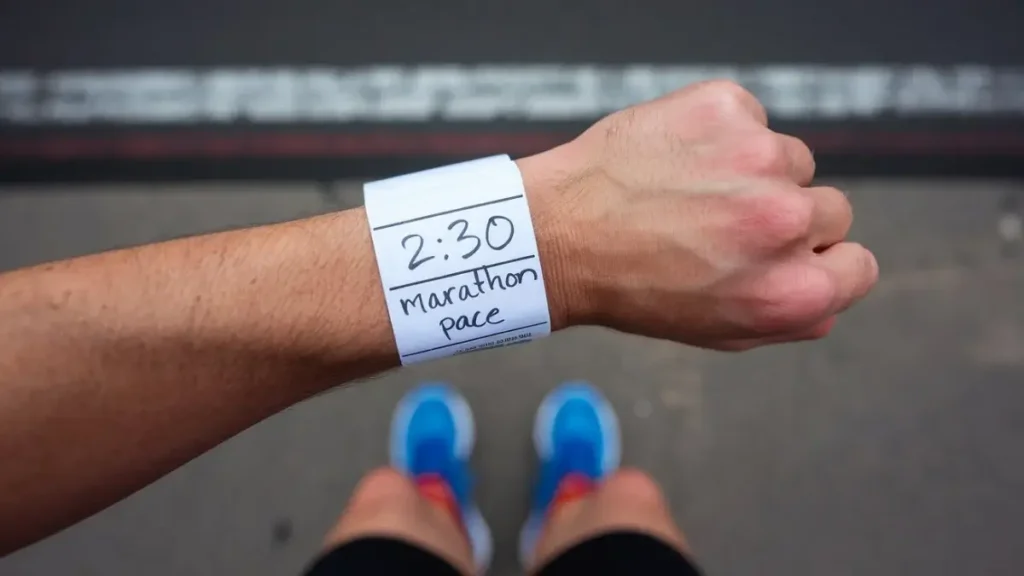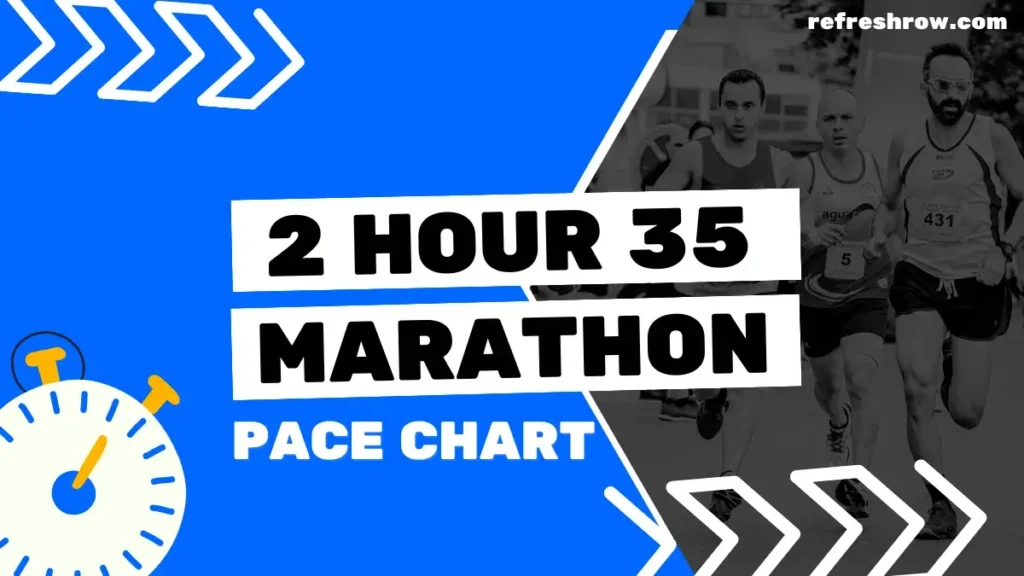To run a 4:25 hour marathon you need to run at a pace of 10:06 per mile or 6:17 per kilometer.
Following the splits below (and shaving off a second), you’ll run a sub 4:25 marathon.
I’d recommend aiming to run 1-2 minutes ahead of the split target time from 10 miles, as you’ll likely come up against crowding on race day.
4:25 Marathon Pace in Miles
| Mile | Split |
|---|---|
| 1 | 10:06 |
| 2 | 20:13 |
| 3 | 30:19 |
| 4 | 40:26 |
| 5 | 50:32 |
| 6 | 1:00:39 |
| 7 | 1:10:45 |
| 8 | 1:20:51 |
| 9 | 1:30:58 |
| 10 | 1:41:04 |
| 11 | 1:51:11 |
| 12 | 2:01:17 |
| 13 | 2:11:24 |
| 14 | 2:21:30 |
| 15 | 2:31:37 |
| 16 | 2:41:43 |
| 17 | 2:51:49 |
| 18 | 3:01:56 |
| 19 | 3:12:02 |
| 20 | 3:22:09 |
| 21 | 3:32:15 |
| 22 | 3:42:22 |
| 23 | 3:52:28 |
| 24 | 4:02:34 |
| 25 | 4:12:41 |
| 26 | 4:22:47 |
| 26.2 | 4:25:00 |
Download
4:25 Marathon Pace in KM
| KM | Split |
|---|---|
| 1 | 6:17 |
| 2 | 12:34 |
| 3 | 18:50 |
| 4 | 25:07 |
| 5 | 31:24 |
| 6 | 37:41 |
| 7 | 43:58 |
| 8 | 50:15 |
| 9 | 56:31 |
| 10 | 1:02:48 |
| 11 | 1:09:05 |
| 12 | 1:15:22 |
| 13 | 1:21:39 |
| 14 | 1:27:56 |
| 15 | 1:34:12 |
| 16 | 1:40:29 |
| 17 | 1:46:46 |
| 18 | 1:53:03 |
| 19 | 1:59:20 |
| 20 | 2:05:36 |
| 21 | 2:11:53 |
| 22 | 2:18:10 |
| 23 | 2:24:27 |
| 24 | 2:30:44 |
| 25 | 2:37:01 |
| 26 | 2:43:17 |
| 27 | 2:49:34 |
| 28 | 2:55:51 |
| 29 | 3:02:08 |
| 30 | 3:08:25 |
| 31 | 3:14:41 |
| 32 | 3:20:58 |
| 33 | 3:27:15 |
| 34 | 3:33:32 |
| 35 | 3:39:49 |
| 36 | 3:46:06 |
| 37 | 3:52:22 |
| 38 | 3:58:39 |
| 39 | 4:04:56 |
| 40 | 4:11:13 |
| 41 | 4:17:30 |
| 42 | 4:23:47 |
| 42.2 | 4:25:00 |
Download
Other Marathon Pace Charts
Targeting a different time?
Check out the Full Marathon Pace Chart in Miles or KM
Or select a specific finishing time below:
| 3:00 | 4:00 | 5:00 | |
| 3:05 | 4:05 | 5:15 | |
| 3:10 | 4:10 | 5:30 | |
| 3:15 | 4:15 | 5:45 | |
| 3:20 | 4:20 | 6:00 | |
| 3:25 | 4:25 | 6:15 | |
| 2:30 | 3:30 | 4:30 | 6:30 |
| 2:35 | 3:35 | 4:35 | 6:45 |
| 2:40 | 3:40 | 4:40 | 7:00 |
| 2:45 | 3:45 | 4:45 | |
| 2:50 | 3:50 | 4:50 | |
| 2:55 | 3:55 | 4:55 |
Training for a 4:25 Marathon
Is 4:25 a Good Marathon Time?
Well, what do the stats say?
Run Repeat conducted a study that contains 19,614,975 marathon results from more than 32,335 races across the globe, here is how a 4:25 marathon compares against age and gender for the races recorded:
| Overall | You’re faster than 51.4% of all runners. |
| Male | You’re faster than 40.5% of males. |
| Female | You’re faster than 66.0% of females. |
| <20 | You’re faster than 49.6% of under 20s. |
| 20-29 | You’re faster than 44.5% of 20-29 year olds. |
| 30-39 | You’re faster than 44.0% of 30-39 year olds. |
| 40-49 | You’re faster than 48.4% of 40-49 year olds. |
| 50-59 | You’re faster than 61.4% of 50-59 year olds. |
| >60 | You’re faster than 80.0% of over 60s. |
Training Runs and Paces for a 4:25 Marathon
To break a 4:25 marathon you’ll need to do some serious distance in your training, I recommend at least 15 miles (24km) per week.
You’re also going to need to make sure you’ve crossed off these milestones for other race distances:
- A 5k in 27:35 mins
- A 10k in 57:50 mins
- A half marathon in 2 hours 2 mins
Training Paces
| Pace | Mins per Mile | Mins per KM |
|---|---|---|
| Easy | 11:23 | 7:04 |
| Steady | 10:06 | 6:16 |
| 10k | 9:16 | 5:45 |
| 5k | 8:53 | 5:31 |
| 1 Mile | 8:15 | 5:09 |
Weekly Mileage Targets
| Target Mileage: | Gradually increase your weekly mileage from 25 miles (40 km) to a peak of 34 miles (55 km). |
| Incremental Increase: | Increase mileage by approximately 10% each week, with every fourth week as a recovery week where mileage is reduced by 20-30%. Make sure to taper for the last 1-2 weeks. |
Long Run Structure
| Total Distance: | Build up to long runs of 20-22 miles (32-35 km). |
| Segment Example: | First 5 miles (8 km): Easy pace, heart rate 140-150 bpm (approximately 12:00/mile or 7:27/km). Next 1 mile (1.6 km): Fast pace at 8:40/mile (5:24/km). Next 5 miles (8 km): Medium effort, heart rate around 160 bpm (approximately 9:40/mile or 6:00/km). Repeat: Repeat the segment twice (5 miles easy, 1 mile fast, 5 miles medium), you can taper the final 2 miles if required. |
Why This Works: Incorporating varied paces within long runs enhances lactate tolerance, which helps on race day when you’ve got to maintain pace despite feeling fatigued. By practicing surges during a run, you can build up your physical and mental resilience (lots of elite marathon runners use these strategies during their training)
Alternating Long Runs: Alternate between structured long runs (easy/fast segments) and easier long runs. For easier long runs, maintain a steady, comfortable pace throughout, focusing on mileage rather than speed to aid recovery.
Speedwork Sessions
| Short Intervals: | – 800m repeats at 4:15 per interval (5:18/km). – Aim for 6-12 repetitions with equal time for recovery. |
| Mile Repeats: | – 1 mile repeats at 8:40 per mile (5:24/km). – Aim for 6-12 repetitions with a 1-2 minute recovery jog. |
| Longer Intervals: | – 2 mile repeats at 8:50 per mile (5:30/km). – Aim for 5-8 repetitions with a 2-3 minute recovery jog. |
Recovery and Rest Days
| Rest Days: | You don’t need to incorporate rest days if you are using recovery runs, but I recommend taking 1 (or a max of 2) per week to allow your body to recover and prevent overtraining. |
| Easy Run Days: | Include 1-2 easy run days per week at a relaxed pace of 12:15/mile (7:36/km), covering 3-5 miles (5-8 km) per day. Try to keep your heart rate below 140 bpm on easy days to ensure proper recovery and aerobic development. |
My Tips to Run a Sub 4:25 Marathon
Start Slow and Build Momentum
One of the biggest mistakes beginners make when they run their first marathon is starting off too fast (This was me!).
The first few miles should feel slow/easy – almost too easy.
Resist the urge to push hard early on or chase pacer flags, and instead focus on finding a comfortable rhythm.
This allows your body to warm up gradually and preserves your energy for the later miles when it really counts.
Remember, it’s much better to finish strong than to burn out halfway through.
(My first London Marathon was amazing, but I hated it at the end, and wish I was in a better mood to enjoy Big Ben!)
Make Recovery Days Non-Negotiable
It’s tempting to think that more miles mean better results.
But rest and recovery are just as important as completing your long runs.
Your muscles need time to repair and grow stronger, especially if you’re new to marathon training.
Build in at least one or two dedicated rest days each week, and consider adding in some active recovery like gentle yoga or a light walk.
This is going to help to prevent injury as well as keep you mentally fresh for the next run.
Practice Mental Resilience on Long Runs
Talking about the mental challenge, it can be just as much a hurdle to overcome as the physical one.
During your long runs, have a go at practicing mental strategies you can use on race day.
Break down the marathon into manageable chunks – think of it as a series of 5Ks or aim for specific milestones like the halfway point.
(Or I like to break it down in water breaks – every 20 minutes)
When you start to feel tired, remind yourself why you’re doing this, or focus on something positive like your breathing or the scenery.
Having the confidence to push through the tough moments during the marathon will be the difference between hitting your target time or not.
Get Comfortable with Being Uncomfortable
There will be moments when you feel out of your comfort zone, whether it’s during a long run, a hill session, or the final stretch of the race.
Embrace these moments as part of the journey.
This is where you grow.
During training, when you hit a tough spot, remind yourself that this discomfort is temporary and that every run is making you stronger.
Give yourself that internal boost.
Learning to be comfortable with discomfort is something that will help with your marathon, as well as the rest of your life.


Row Brown is the founder of Refresh Row. He is a keen marathon runner, his favorite being the London Marathon. He’s now set himself the mission of Running the Entire Length of Spain, which is scheduled for late 2024.


